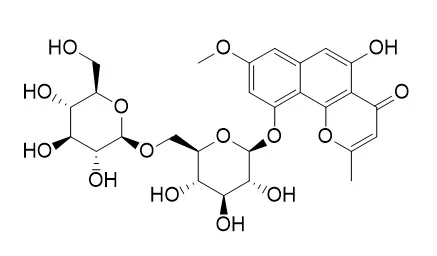Cassia obtusifolia Linn. have been used to improve vision, inflammatory diseases, and as hepatoprotective agents and to promote urination from ancient times.
METHODS AND RESULTS:
In the present study, we investigated the influence of glycosylation of components of C. obtusifolia and structure-activity relationships (SARs) with respect to the inhibition of acetylcholinesterase (AChE), butyrylcholinesterase (BChE), and β-site amyloid precursor protein (APP)-cleaving enzyme 1 (BACE1), which are related to Alzheimer's disease (AD). All six C. obtusifolia-derived compounds, rubrofusarin (1), rubrofusarin 6-O-β-d-glucopyranoside (2), rubrofusarin 6-O-β-d-gentiobioside (3), nor-rubrofusarin 6-O-β-d-glucoside (4), isorubrofusarin 10-O-β-d-gentiobioside ( Isorubrofusarin 10-gentiobioside, 5), and rubrofusarin 6-O-β-d-triglucoside (6) showed promising inhibitory activity against AChE/BACE1. Compounds 3 and 4 showed most significant inhibition against AChE and BACE1, respectively. The SARs results emphasized the importance of gentiobiosyl moiety in the rubrofusarin for AChE inhibition, whereas the presence of hydroxyl group at C-8 and the glucosyl moiety at the C-6 position in the nor-rubrofusarin appeared to largely determine BACE1 inhibition. Kinetics and docking studies showed the lowest binding energy and highest affinity for mixed-type inhibitors, 3 and 4. Hydrophobic bonds interactions and the number of hydrogen bonds determined the strength of the protein-inhibitor interaction.
CONCLUSIONS:
These results suggest that C. obtusifolia and its constituents have therapeutic potential, and that the SARs of its active components are further explored with a view towards developing a treatment for AD. |






 Cell. 2018 Jan 11;172(1-2):249-261.e12. doi: 10.1016/j.cell.2017.12.019.IF=36.216(2019)
Cell. 2018 Jan 11;172(1-2):249-261.e12. doi: 10.1016/j.cell.2017.12.019.IF=36.216(2019) Cell Metab. 2020 Mar 3;31(3):534-548.e5. doi: 10.1016/j.cmet.2020.01.002.IF=22.415(2019)
Cell Metab. 2020 Mar 3;31(3):534-548.e5. doi: 10.1016/j.cmet.2020.01.002.IF=22.415(2019) Mol Cell. 2017 Nov 16;68(4):673-685.e6. doi: 10.1016/j.molcel.2017.10.022.IF=14.548(2019)
Mol Cell. 2017 Nov 16;68(4):673-685.e6. doi: 10.1016/j.molcel.2017.10.022.IF=14.548(2019)